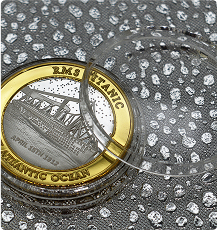
Ah, treasure coins. The mere mention conjures images of swashbuckling pirates, sunken galleons, and buried chests brimming with gold. But before you start planning your early retirement based on that "priceless" doubloon you picked up at a flea market, let's dive into the nitty-gritty of coin authentication. After all, in the world of numismatics, all that glitters is not necessarily gold (or silver, for that matter).
Replica treasure coins showcasing various designs

The Allure and Pitfalls of Treasure Coins
From Spanish doubloons to ancient silver pieces, these historical artifacts carry more than just monetary value—they're tangible links to our past. However, with great value comes great temptation for forgery. It's estimated that up to 80% of "rare" coins sold online could be fakes or reproductions. Yikes! But fear not, aspiring coin sleuths. We're about to equip you with the tools to separate the wheat from the chaff (or the gold from the fool's gold, if you will).
Certificates of Authenticity: Your Paper Trail to Legitimacy
Let's start with the most straightforward method: Certificates of Authenticity (CoAs). These documents are the coin world's equivalent of a pedigree.
What to Look For in a CoA:
-
Specific Details: A legitimate CoA should include the coin's weight, dimensions, and recovery context. If it's as vague as your ex's excuses, that's a red flag.
-
Reputable Issuers: Companies like Mel Fisher's Treasures offer lifetime guarantees with their CoAs, particularly for shipwreck coins like those from the infamous Nuestra Señora de Atocha.
-
Third-Party Grading: For an unbiased assessment, look for certificates from neutral graders like NGC (Numismatic Guaranty Corporation) or PCGS (Professional Coin Grading Service).
Pro Tip: A CoA alone doesn't guarantee authenticity. Think of it as a strong starting point, not the finish line.
Getting Physical: Hands-On Authentication Techniques
Now, let's roll up our sleeves and get hands-on with some physical inspection methods.
Weight Verification
Every coin type has a specific weight range. For instance, a Spanish 8-escudo doubloon should tip the scales at around 27 grams. If your "doubloon" weighs as much as a potato chip, you might want to reconsider its authenticity (and perhaps your snacking habits).
Examining a gold-colored coin with irregular shape

Surface Analysis
Struck Counterfeits
Look for blurred details or incorrect alignment. Authentic coins should have crisp, well-defined features.
Cast Fakes
These imposters often reveal themselves through seam lines or porous surfaces—telltale signs of mold casting.
Edge Lettering
Many Spanish colonial coins feature unique edge designs. Inconsistencies here are often the undoing of even sophisticated fakes. Think of it as the coin's fingerprint—unique and hard to replicate perfectly.
Digital Sleuthing: High-Tech Authentication Tools
Welcome to the 21st century, where even coin authentication has gone digital.
High-Resolution Imaging
Zoom in on surface marks to detect artificial aging or tooling. It's like CSI, but for coins (and with fewer dramatic sunglasses removals).
Online Databases
Platforms like NGC's Coin Explorer are treasure troves of information. Cross-reference your coin's details here, or dive into specialized forums. Just remember, the internet can be both a fountain of knowledge and a cesspool of misinformation—choose your sources wisely.
UV Light Testing
Some modern fakes glow under UV light due to non-period-accurate metals. If your "ancient" coin lights up like a disco ball, it's probably about as authentic as a three-dollar bill.
Case Studies: Learning from the Legends
Mel Fisher's Atocha Coins
These coins, recovered from the 1622 shipwreck of the Nuestra Señora de Atocha, come with robust CoAs tied to the ship's manifest. They're the gold standard (pun intended) of authenticated treasure coins.
Spanish Doubloons: A Counterfeiter's Favorite
Often faked using brass cores plated in gold, these coins require extra scrutiny. Verify the density—real gold should be about 19.3 g/cm³. If it's significantly off, your doubloon might be more "double-crossed" than doubloon.
Ancient Silver: The Tarnished Truth
Authentic ancient silver coins often display natural toning and "flow lines" from hand-striking. If your "ancient" silver piece looks as shiny as a new dime, it might be time to question its provenance.
Detailed replica coins showcasing various designs

Avoiding Common Pitfalls
-
Don't Be Dazzled by Appearance Alone: High-quality struck counterfeits can mimic wear patterns convincingly. Beauty is only skin deep, especially in the coin world.
-
Beware the Tall Tale: Unverifiable backstories (like "found in great-grandpa's attic") should raise eyebrows. Unless your great-grandpa was a known pirate or shipwreck survivor, of course.
-
When in Doubt, Seek Expertise: For high-value coins, always get third-party certification. Your wallet (and your pride) will thank you.
Wrapping Up: The Art of Authentic Authentication
Authenticating treasure coins is part science, part detective work, and a dash of intuition. It's a skill honed through experience, knowledge, and sometimes, costly mistakes. But armed with these tools and techniques, you're well on your way to becoming a numismatic Sherlock Holmes.
Remember, in the world of treasure coins, skepticism is your best friend. Question everything, trust but verify, and never be afraid to seek expert opinions. After all, the thrill of the hunt is half the fun—just make sure you're hunting for real treasure, not fool's gold.
So go forth, budding coin authenticators. May your doubloons be genuine, your silver pieces ancient, and your numismatic adventures always exciting (and profitable)!
 727-585-4502
727-585-4502



